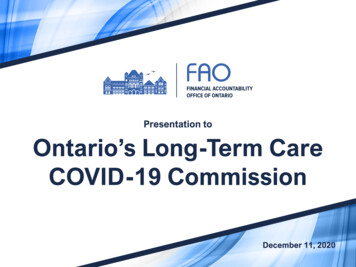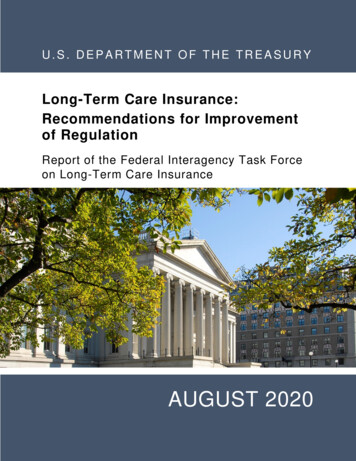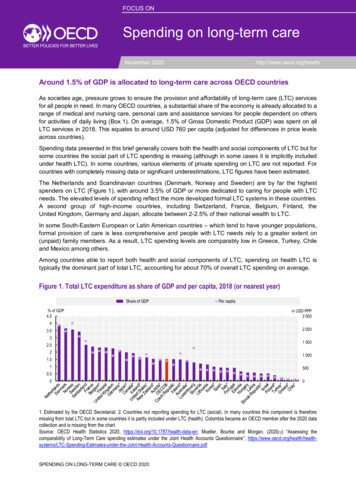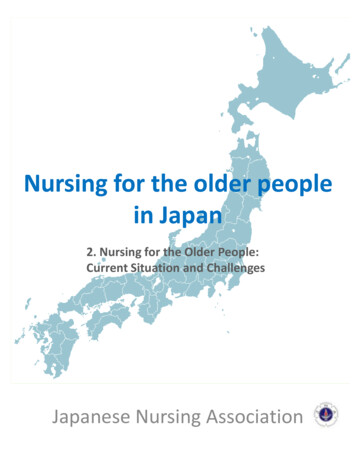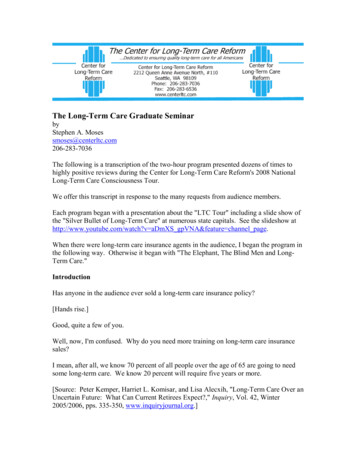
Transcription
The Long-Term Care Graduate SeminarbyStephen A. Mosessmoses@centerltc.com206-283-7036The following is a transcription of the two-hour program presented dozens of times tohighly positive reviews during the Center for Long-Term Care Reform's 2008 NationalLong-Term Care Consciousness Tour.We offer this transcript in response to the many requests from audience members.Each program began with a presentation about the "LTC Tour" including a slide show ofthe "Silver Bullet of Long-Term Care" at numerous state capitals. See the slideshow athttp://www.youtube.com/watch?v aDmXS gpVNA&feature channel page.When there were long-term care insurance agents in the audience, I began the program inthe following way. Otherwise it began with "The Elephant, The Blind Men and LongTerm Care."IntroductionHas anyone in the audience ever sold a long-term care insurance policy?[Hands rise.]Good, quite a few of you.Well, now, I'm confused. Why do you need more training on long-term care insurancesales?I mean, after all, we know 70 percent of all people over the age of 65 are going to needsome long-term care. We know 20 percent will require five years or more.[Source: Peter Kemper, Harriet L. Komisar, and Lisa Alecxih, "Long-Term Care Over anUncertain Future: What Can Current Retirees Expect?," Inquiry, Vol. 42, Winter2005/2006, pps. 335-350, www.inquiryjournal.org.]
We know long-term care is a very expensive prospect, whether it's provided in a nursinghome, in assisted living, or in a person's own home.I assume you do not get in front of people with the offer of private long-term careinsurance as a solution to this problem unless and until you've qualified them, bothmedically and financially. Surely, you wouldn't want to waste their time or yours.So, here's my problem. You know they need it. You know they can afford it. You'veanswered all their objections. So I assume this is a slam-dunk sale, right? Do you everstill have the experience of offering this product to qualified people who need it, and theydon't buy?Let the record show that there was a titter of amusement at that statement.Well, then, I don't understand. What do they tell you to get you to leave without a signedcontract?Audience: "It costs too much."Moses: "Right, I'd rather spend dollar-dollars later than nickel-dollars now." Makes nosense. What else?Audience: "My kids will take care of me."Moses: "Sure, I'm just fine with my daughter or daughter-in-law having to quit her job ortake early retirement so she can change my diapers someday." Anything else?Audience: "Denial, I'll never go to one of those places."Moses: "Yeah, I'll never go to one of those places. I'd shoot myself first. That's usuallythe guy right? Macho man. Here's the truth. At age 85, there's a 47 percent probabilityyou'll already have Alzheimer's Disease. Two-thirds of all residents in long-term carefacilities are cognitively impaired. The reality, Mr. Jones, is that when it comes time touse it, you won't remember why you bought the gun!"Or, when you have the stroke, you'll be on a cruise ship, where they don't let you takefirearms aboard."Now, the reason I begin the program in this way is to show you that the excuses peoplegive to get you to leave without a signed long-term care insurance contract have verylittle to do with the real reasons they don't buy. Something else is going on under thesurface.But, what? That's what today's program is about. I estimate that 80 percent of theAmerican public who could, should and would buy long-term care insurance never evenrises to the level of concern about the issue to ask "who pays?"
In fact, I'd say the American public has no idea who pays for long-term care. They don'tknow if it's Medicaid, Medicare, or Santa Claus. Nor do they care.Furthermore, even if they do wonder who pays for long-term care, they have a prettygood idea that somebody must pay. After all, you don't see Alzheimer's patients dying inthe gutter.In other words, for most people, the issue of long-term care probably doesn't even reachthe level of full consciousness in their minds. So you never see them.And for the 20 percent of the potential LTCI market that you do get in front of, usuallybecause they've been through a crisis with a family member recently, you only sell a thirdto a half for the same reason. They just don't believe they're as at risk as you're saying.Today's ProgramMy goals in today's program are threefold:First, I want to show you why the public remains asleep about the risk and cost of longterm care.Second, I want to show you why everything is about to change.And third, I want to explain how you can help more people protect themselves against thereal LTC risk and cost in the meantime.Here's the danger:If your clients are looking through the rear-view mirror at the issue of long-term care,what they are probably seeing is how Mom and Dad or Grandpa and Grandma gotnursing home care funded by Medicaid.If you can help them look through the windshield, however, what they're going to see is abrick wall of fiscal reality approaching at 100 miles an hour.The way long-term care has been funded in the past is about to change dramatically.Individuals and families will be much more personally responsible for their own care inthe future than they have been in the past. Understanding why long-term care is the wayit is today is critical to preparing for how long term care will be funded in the future.I'm going to approach today's topic from three different angles.First, we'll look at the big picture, the long-term care service delivery and financingsystem in terms of its full complexity.
Second, we'll trace the history of long-term care service delivery and financing in order tounderstand how the system became so dysfunctional.And third, we'll analyze the current system in order to explain what has to change andhow and when it will change.The Elephant, the Blind Men, and Long-Term CareThere is an old East Indian allegory about an elephant and some blind men. It goes likethis. Six blind men approached an elephant. Depending on what part of the elephantthey touched, each thought he was grasping something entirely different.One blind man touched the trunk and assumed it was a hose. Another blind man touchedthe tail and thought it was a rope. A third blind man patted the flank of the elephant andassumed it was the side of a barn.The point of this story is that with any complex entity, until you understand each of itsfacets and all of their interrelationships, you really don't know with what you're dealing.It seems to me that the old story of the elephant and the blind men is a perfect analogy forthe complex issue of long-term care. If you're looking at long-term care only from theperspective of long-term care insurance, you're not really seeing the whole picture.The same holds true for all the other blind men of long-term care. I mean by that, thereare several interest groups or stakeholders concerned about long-term care. They eachview the elephant of long-term care very differently, and very provincially.Let me show you what I mean. If I asked you to name one of the blind men of long-termcare, one of the key interest groups in the issue of long-term care, what would you say?Audience: "The government?"Moses: Exactly. The government pays for the vast majority of all expensive long-termcare in the United States. Medicaid and Medicare are the heaviest funders of nursinghome care and home health care. Medicaid, especially, is the 800-pound gorilla of longterm care financing.Medicaid funds most nursing home care, and a good portion of home health care in theUnited States. But Medicaid is bankrupting the states. It accounts for 22 percent to 25percent of state budgets and long-term care is a third to a half of the average state'sMedicaid expenditures. Medicaid long-term care costs are breaking the bank.Despite these huge expenditures, Medicaid can't afford to pay adequately for long-termcare. That's true already, and will be more true in the future, when the baby boomersretire and ultimately need long-term care themselves. Medicaid reimburses nursing
homes less than the cost of providing the care: 6.3 billion annually and 19.55 per BedDay less than cost.[Source: "A Report on Shortfalls in Medicaid Funding for Nursing Home Care,"December 2011,http://www.ahcancal.org/research ls%20Report%202011.pdf]How do nursing homes survive under those circumstances? I'll explain that later in theprogram. I'll also explain why it can't continue.So, when the government looks at the elephant of long-term care, it sees a gigantic fiscalblack hole. Government can't afford to fund the long-term care it pays for today, muchless in the future. Yet government continues to pay for most long-term care not only forthe poor, but for the middle class and affluent as well.What might be another blind man of long-term care?Audience: "The public, consumers, people who need long-term care."Moses: Absolutely, somebody has to receive the care, right? So what does the publicsee when it looks at the elephant of long-term care?The public's response to long-term care is "what, me worry?" Most people have no ideawho pays for long-term care. They're in denial. Hence the cliché among long-term careinsurance agents: "Denial is not a river in Egypt."But here's the problem: if long-term care is such a huge risk and cost, how can the publicremain in denial? What enables their denial?Do you think it could have something to do with the fact that since 1965, the UnitedStates government and state governments have paid for most long-term care provided innursing homes or through home health care?There is another blind man of long-term care, closely related to the public, but differentenough for us to identify it separately.The third blind man of long-term care is the "senior advocates." Now, when I ask aboutorganizations that represent seniors and advocate on their behalf, what comes to yourmind?Audience: "AARP."Moses: Right, but also the Alzheimer's Association, the National Council on the Aging,the American Society on Aging and many, many others.
What role do these groups play? Are they strong advocates for personal responsibilityand private financing to supplement public financing of long-term care? Are theywonderful sources of medically and financially qualified leads for private long-term careinsurance producers?The answer to these questions is "no." Instead of warning their members that long-termcare will require more personal responsibility in the future and urging them to save,invest or insure for the risk, these groups often pooh-pooh LTC insurance, saying mostpeople are too young, too old, too rich or too poor to buy it. They are principally focusedon attracting more financing for long-term care from the government. But as we'vealready established, the government has no extra money for LTC programs. It's ahopeless task to squeeze more blood out of that turnip.There's also a subcategory of the senior-advocacy blind man of long-term care. That's theelderlaw bar, including the Medicaid estate planning attorneys who help affluent peopleself-impoverish to become eligible for Medicaid. We'll talk more about these people andhow they do what they do later in the program. For now, it's important to recognize thatthe more people depend on scarce government financing of long-term care, the harder itis for the government to provide quality care to people truly in need.So, how about another blind man of long-term care? What's another group critical toproviding long-term care?Audience: "Nursing homes?"Moses: Correct, but home care providers and assisted living facilities also. Were talkingabout the providers of long-term care. Here it's important to distinguish betweenproviders who receive most of their funding from government versus providers whoreceive most of their funding from private sources.Nursing homes and home health care agencies are largely funded by Medicaid andMedicare. Consequently, the tremendously powerful trade associations representingnursing homes and home care agencies are principally focused on getting the governmentto provide more reimbursement to them. Most of their revenue has always come fromgovernment. So that's where they focus their lobbying and public policy advocacyefforts. They don't spend much time or money on encouraging responsible long-termcare planning for the future.I think you will agree that LTC providers are rarely good sources of qualified leads forprivate long-term care insurance. These organizations are struggling to survive nextweek, next month, next quarter. That's why they are not particularly concerned aboutwho's going to pay the bills 15 or 20 years from now when someone who buys a longterm care insurance policy today might finally go on claim.Assisted living facilities, on the other hand, are in a completely different position. Theirfunding comes 90 percent from private sources, mostly out-of-pocket expenditures by
residents and their families. So, you would think that assisted living facilities would befocused on increasing private financing of their services, including through private longterm care insurance. But they're not.Why? Assisted living facilities are also struggling financially. They too can't wait 20years for more private payers. In the meantime, they are tempted to take more Medicaidmoney, even at rates less than the cost of providing the care, because any reimbursementis better than none for an empty bed.Thus, assisted living facilities are hurt in two ways. Medicaid subsidized nursing homecare draws away potential assisted living residents and assisted living facilities aretempted to accept prohibitively low-reimbursement Medicaid residents as a way to fillbeds. I've published in assisted living trade journals in the past warning that industryagainst the mistake of taking the same Primrose Path as nursing homes toward more andmore dependency on public financing.A fifth blind man of long-term care is the financiers. These are the people whoprovide the debt and equity capital to build, operate, and maintain long-term carefacilities. The LTC financiers represent Wall Street. They represent investors. If theycan make more money in a sector of the economy other than long-term care, that is wherethey will invest their investors' capital. Capital always migrates to its highest and bestuse.The financiers have been burned by long-term care in the past. In the late '80s and early'90s, they invested heavily in assisted living facilities. They assumed that nursing homecare was highly undesirable and that the public was spending down into impoverishmentfor nursing home care, so that if assisted living facilities (ALFs) were built, the newservice modality would be much more attractive to consumers. They invested heavily inthese beautiful Victorian mansions, but found the new ALFs could not fill fast enough tobe profitable and provide the expected investment returns. Wall Street, once burned,remains twice cautious.Several years ago, I attended a conference of the National Investment Center, NIC, aneducational and trade association for LTC financiers. The first evening I found myself ina giant Washington, DC hotel auditorium. There were blinking neon lights in the shapeof cocktail glasses. The room was full of distinguished gentlemen in three-piece suits. Ithought I'd hit the mother lode. "Follow the money," they say. "Show me the money."That's the key to understanding any industry, I thought. If I can just show these peoplehow vulnerable long-term care is to public financing and what a great potential privatefinancing through long-term care insurance would have, they should get on board.Boy, was I wrong. I found out they only look at specific projects. "Do the demographicsjustify building a facility in this particular location at this particular time?" is the onlyquestion they ask. They gave no level of concern to the fact that public financing oflong-term care is collapsing and private financing of long-term care is not increasing. Infact long-term care insurance is of no concern to them at all. LTC insurance paid 6.6
billion in claims in 2011 (AALTCI, 2012), but that's within a market of over 213 billiona year (CLTCR, 2012). Long-term care insurance isn't even a flyspeck on the windshieldof the larger long-term care marketplace. And it won't be a significant factor to theseinvestment advisors in the future, because too few people are purchasing long-term careinsurance for the product to play an important role in funding long-term care in theforeseeable future.Nevertheless, investors in long-term care are taking a larger interest lately. I've beeninvited to consult with many Wall Street people on the wisdom of investing in long-termcare service delivery and financing. But the bottom line right now is that investors canmake more money in other sectors of the economy than in long-term care. Consequently,we have a dearth of debt and equity capital to fund long-term care.This is a serious problem, because America's nursing home infrastructure is antiquated.The average nursing home in the United States is 37 years old. The average lifeexpectancy of a nursing home is only 40 years. The Age Wave is about to crest and crashon long-term care service delivery in the United States. Yet, we have an institutional biasin the system, an excessive dependency on nursing home care. We have anunderdeveloped home and community-based services infrastructure. And we lack theinvestment capital to deal with these shortages.Well, there is one more blind man of long-term care, can you tell me what it might be?Audience: "Long-term care insurance?"Moses: Correct. I always put the long-term care insurance industry under the elephant'stail. [Laughter] You'll see why.What does the long-term care insurance industry see when it looks at the elephant oflong-term care? Well, 30 years ago the LTCI industry looked at long-term care and said:"Wow! What an opportunity! 77 million baby boomers are getting older. Everyoneknows that most people have to spend down their life savings before they get any helpfrom the government. Then all they get is nursing home care, which nobody wants. So,if we just offer an insurance product to help them spread that risk and purchase the carethey want, it's bound to be popular and very profitable."Is that how it turned out? Not by a long shot. Although actuaries who were around at thebeginning have told me they expected 75 percent of all Americans to be protected forlong-term care by now, the actual market penetration for private long-term care insuranceis less than 10 percent today.Long-term care insurers got into the business with stars in their eyes. Companies,brokers and agents entered the industry with high expectations. They made a fewrevolutions and headed out the other side of the revolving door. Turns out long-term care
insurance is much harder to sell than was originally thought. A key goal of today'sprogram is to explain why that is and what has to change to fix it.Those are the six blind men of long-term care. We've now taken the elephant of longterm care apart. Here's what we found. The government funds most long-term care but can't afford to do so in the future. The public is asleep about the risk of long-term care because the government haspaid for most of it since 1965. So the public is about to get a rude awakening asgovernment is forced to withdraw slowly from widespread LTC funding. Senior advocacy organizations, instead of working to wake the public up to theneed for long-term care planning, have put all their lobbying energy and resourcesinto promoting more government financing of long-term care. But that's a deadend. And ironically, at least for the time being, the easiest money of all to be made inlong-term care is made by Medicaid planning attorneys who wave a magic legalwand and make the financial liability for long-term care disappear for theiraffluent clients--after the insurable event has occurred! Long-term care providers are hooked on "LTC crack." They invest all of theirenergy, resources and money into squeezing more revenue out of the government.But again, that's beating a dead horse, drilling a dry hole. Nursing homes remain a powerful lobby because they get and have gotten somuch government financing for so long. Home and community-based servicesproviders have little clout, because the government co-opted a private market fortheir services by paying mostly for nursing home care for over four decades. Long-term care financiers are few and far between, because they can make moremoney for their investors in other sectors of the economy. Hence, we have adearth of debt and equity capital to build, operate and maintain long-term carefacilities in the United States at the very time the demand for long-term care isabout to explode. And finally, long-term care insurance remains a stunted market, because thegovernment has paid for most long-term care since 1965, the public is asleepabout the risk, and the long-term care providers are hooked on public funding.Get the picture? What a mess! When you look at the whole elephant of long-term care,take it apart and put it back together again as we just have, what you see is a verycomplicated interrelationship between a lot of interconnected parts resulting in a totallydysfunctional whole.
How in the world did our country's long-term care service delivery and financing systemget into such a dangerous mess? That's where we're going next with today's program.History of LTC and Why it Matters for Financial Advisors and LTCI ProducersI want to change gears now and take another approach to the LTC issue. We haveestablished so far that the elephant of long-term care is a very complicated animal. It'scomprised of many competing interest groups, each and all of which have something togain from continuation of the status quo.We've established that the United States has a welfare-financed, nursing home basedlong-term care system in the wealthiest country in the world where nobody wants to go toa nursing home. And yet most people are asleep about the risk and cost of long-termcare. Until we understand how this status quo came to be and why, we can hardly expectto identify the right corrective actions.So I want to turn now to the history of long-term care service delivery and financing.How did we get into the mess we're in?Something really important happened in 1965. Two new government programs wereestablished. Do you know what they were?Right, Medicare and Medicaid.Medicare, of course, was designed to provide acute health care to the elderly. ButCongress decided that something really needed to be done for low income people as well.So they added Medicaid as kind of an afterthought to Medicare. Then, as an afterthoughtto that afterthought, Congress decided that something should also be done for agingAmericans who need long-term care. So they added nursing home care to Medicaid forpeople over the age of 65.In the beginning, there were no transfer of assets restrictions interfering with eligibilityfor Medicaid long-term care. There was no estate recovery mandate requiring peoplewith sheltered wealth to pay back the cost of their care. If you were over the age of 65, itwas easy to get the government to pay for nursing home care.The public isn't stupid. They figured: "You mean, if we want to take care of Grandma athome, we'll have to pay for it 100 percent out of our own pockets? But if we put her in anursing home, the government will not only pay for her care but send in surveyors tomake sure she receives quality care? That's a no-brainer."The nursing home industry isn't stupid, either. They said. "You mean the government isgoing to put a giant pot of money out in the middle of the country, somewhere aroundKansas or Nebraska, and all we have to do is build nursing homes, offer the beds topeople who want long-term care, and the government will pay? Terrific. Bring it on."
Medicaid Nursing Home Costs ExplodeP.J. O'Rourke, the political satirist, likes to say "If you think health care is expensivenow, just wait until it's free."For all intents and purposes, the government made nursing home care free in 1965.That had the effect of crowding out a market for privately financed home andcommunity-based care. Why pay out of pocket for home care services, adult day care,respite care or assisted living, when the government provides nursing home care?For the same reason, a market for long-term care insurance to pay for home care andnursing home care was slow to develop and remains stunted to this day.By the mid-1970s, I was working for the Health Resources Administration in Rockville,Maryland. That's part of the U.S. Public Health Service. I saw what happened next, upclose and personal.Predictably, the cost of Medicaid financed nursing home care exploded. The public fillednew nursing home beds as fast as the nursing home industry could build them. "Roemer'sLaw" said: "A built bed is a filled bed."[See http://en.wikipedia.org/wiki/Roemer's law]The government looked at the exploding cost of nursing home care and concluded thatsomething had to be done. But instead of addressing the cause--that is, the fact thatgovernment had made nursing home care free or radically subsidized resulting in higherconstruction, utilization and expenditures--they attacked the symptom, the increasingcosts.The government figured "they can't charge us for a bed that doesn't exist." So, stategovernments began to require nursing homes to get permission before they build newfacilities. Nursing home companies had to obtain a "certificate of need" or CON beforebuilding new skilled nursing facilities.Now, this arrangement was fine with the nursing home industry. For anyone already inthat business, the Certificate of Need only meant that they now had a governmentenforced monopoly. They might not be able to build more nursing homes, but neithercould their potential competition. Since the nursing homes' growth was restricted by thislimit on supply, however, the industry simply started charging more for the beds theyalready had.That was predictable. In any economic system, when supply goes down or is artificiallyrestrained from going up, price tends to increase. You don't need a PhD in economics tofigure that out, but the government didn't see the consequences coming.
The cost of Medicaid financed nursing home care continued to explode. Once again, thegovernment knew it had to take action. And once again, it failed to address the cause-i.e., free government financed nursing home care--and went instead after the symptom-skyrocketing costs caused by increasing charges to Medicaid by the nursing homeindustry.So the government told the nursing home industry they could no longer charge whateverthey wanted to charge for nursing home care. Medicaid capped its reimbursement rates.This was the origin of the differential between the very low Medicaid reimbursementrates for long-term care and the relatively high private pay rates. Today, Medicaid paysonly about two-thirds of the private-pay rate for nursing home care. Private payers haveto pay half again as much as Medicaid reimburses for people in the same nursing home,sometimes in the same room as the private payers.Quality CollapsesWith supply AND price capped, what do you think happened to demand? Of course,demand went through the roof. In the mid-1980s, nursing homes were 95 percentoccupied. At the same time, hospitals were only 55 percent to 60 percent full. If anursing home was willing to accept Medicaid's low reimbursement rates, it could fill allof its beds . . . no matter what kind of care it offered. Consequently, quality of carecollapsed in principally Medicaid-financed nursing homes.Once again, Congress took note. Even though quality plummeted, costs continued toexplode. True to form, however, government attacked the symptom (poor quality)instead of the cause (public financing). So Congress went to the nursing home industryand said, in paraphrase:"This is America. We cannot tolerate poor quality of care in our nursing homes. Youmust improve the care. You must hire more nurse's aides; you must train them better;you must pay them more. Make sure you dot every I and cross every T according tostricter regulations. And if you don't, we will hit you with fines and other penalties."That was OBRA '87, the Omnibus Budget Reconciliation Act of 1987. In 2007, wecelebrated the 20th anniversary of that law. Thankfully, it worked, and quality of care inAmerica's nursing homes is top notch today. [Audience snickers.] Well, not exactly. Ifanything, the problems are worse than ever today.But when OBRA '87 passed, the nursing home industry wasn't displeased. They said, inessence, "We're not in this business just to make a lot of money. We want to provideloving and compassionate care. We love the idea that you want us to hire more people,train them better and provide higher-quality care. Only one question though, how muchmore are you going to reimburse us under Medicaid to make this possible?"And the government responded "Money? We don't have any of that. We just demandthat you do all these new things."
Nursing Homes Sue MedicaidWell, now the nursing home industry was caught between the rock of inadequatereimbursement and the hard place of mandatory quality. If they tried to attract moreprivate payers at the higher private-pay rate, they were accused of discriminating againstMedicaid recipients. If they tried to cut costs, they were accused of providing poor care.It was a hopeless situation. So the nursing home industry turned to the courts.Under the "Boren amendment," which was part of OBRA '81, the nursing home tradeassociations in many states began suing their state Medicaid programs for higherreimbursement under Medicaid. The Boren amendment said in essence: "State Medicaidnurs
The Long-Term Care Graduate Seminar The Long-Term Care Graduate Seminar by Stephen A. Moses smoses@centerltc.com 206-283-7036 The following is a transcription of the two-hour program presented dozens of times to highly positive reviews during the Center for Long-Term Care Reform's 2008 National Long-Term Care Consciousness Tour.



